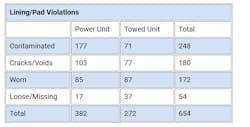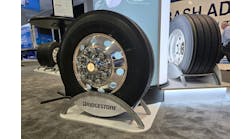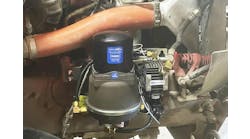Brake Safety Week results highlight stand-alone, 20% criterion issues
The Commercial Vehicle Safety Alliance has released its results from 2024’s Brake Safety Week, which took place from August 25-31. This year, 12.8% of 16,725 inspected vehicles had out-of-service (OOS) brake-related violations, resulting in 2,149 vehicles being placed out of service.
This ratio has remained consistent for the past four years. Despite the number of inspections dropping from over 43,000 in 2020 to 16,725 in 2024, the percentage of out-of-service brake violations has fallen between 11 to 14%. Additionally, while there were 2,150 fewer inspections in 2024 than in 2023, inspectors found only 226 fewer OOS brake violations, revealing the consistency of brake issues in the transportation industry despite an ongoing focus on safety and inspections.
Of the OOS violations during 2024’s Brake Safety Week, the most common issue was stand-alone brake violations. This includes issues with brake hoses, drums, rotors, tractor protection systems, parking brakes, air tanks, and air loss.
“Basically, [stand-alone brake violations are] brake items that are not part of the service brake system,” explained Kerri Wirachowsky, director of inspection programs, CVSA. “The brake drums and rotors are stand alone though even though they are part of the service brake system because of the potential hazard of a broken piece of a brake drum falling out.”
Inspectors found 1,355 violations of this type, and they accounted for 63.1% of OOS violations.
The second most common violation category was the 20% defective brakes criterion, which accounted for 56.6% of violations.
“[The 20% defective brake criterion] results from an accumulation of brake violations, but most commonly results from improper brake adjustment or inoperable service brakes,” Jeremy Disbrow, roadside inspection specialist for CVSA, told Fleet Maintenance last month. “The data shows that brake adjustment is a chronic problem, so carriers need to find a way to address this issue with their drivers.”
Finally, just over 10% of OOS violations were steering axle brake issues, with all of these violations potentially overlapping to place a truck OOS.
Examining brake lining and pads
Additionally, the focus for Brake Safety Week in both 2023 and 2024 was lining and pad violations. These issues can include loose, missing, and worn brake lining and pads, as well as cracks, voids and contamination.
“Although lining/pad violations are not necessarily out-of-service violations, CVSA selected lining/pads as the focus for this year’s Brake Safety Week because brake lining/pad violations still affect a motor carrier’s safety rating,” the Alliance noted in 2023’s Brake Safety Week results. “If left unaddressed, brake lining/pad violations may lead to more serious problems and can be out-of-service violations if they are on the steering axle or combined with other brake violations for the 20% brake criterion.”
For 2024, inspectors found 382 lining/pad violations on tractor units, and 272 violations on trailer units, for a total of 654 violations. While this is an overall improvement from 2023’s 682 lining/pad violations, contaminated pads and cracks and voids remained the top two issues from 2023 into 2024.
For the U.S. specifically, inspectors held 14,692 examinations throughout the country, uncovering 1,900 brake-related OOS violations for a slightly higher OOS rate of 12.9%. They also found lining and pad violations on 310 power units and 172 towed units. And in 18 U.S. states, inspectors with performance-based brake testers (PBBT) inspected 452 vehicles, which resulted in 26 failures.
2025’s Brake Safety Week is scheduled for August 24-30. For carriers to drive down the percentage of OOS brake violations over the next year, Wirachowsky emphasized that drivers need consistent and constant training on brake safety inspections, and an understanding that brake safety is as much their responsibility as the maintenance department’s.
“Many times I have presented to drivers or taught industry courses, and they feel it is either not the responsibility of the driver to inspect the brakes or not possible for the driver to inspect the brakes,” she noted. “This is not a true statement with proper training.”





